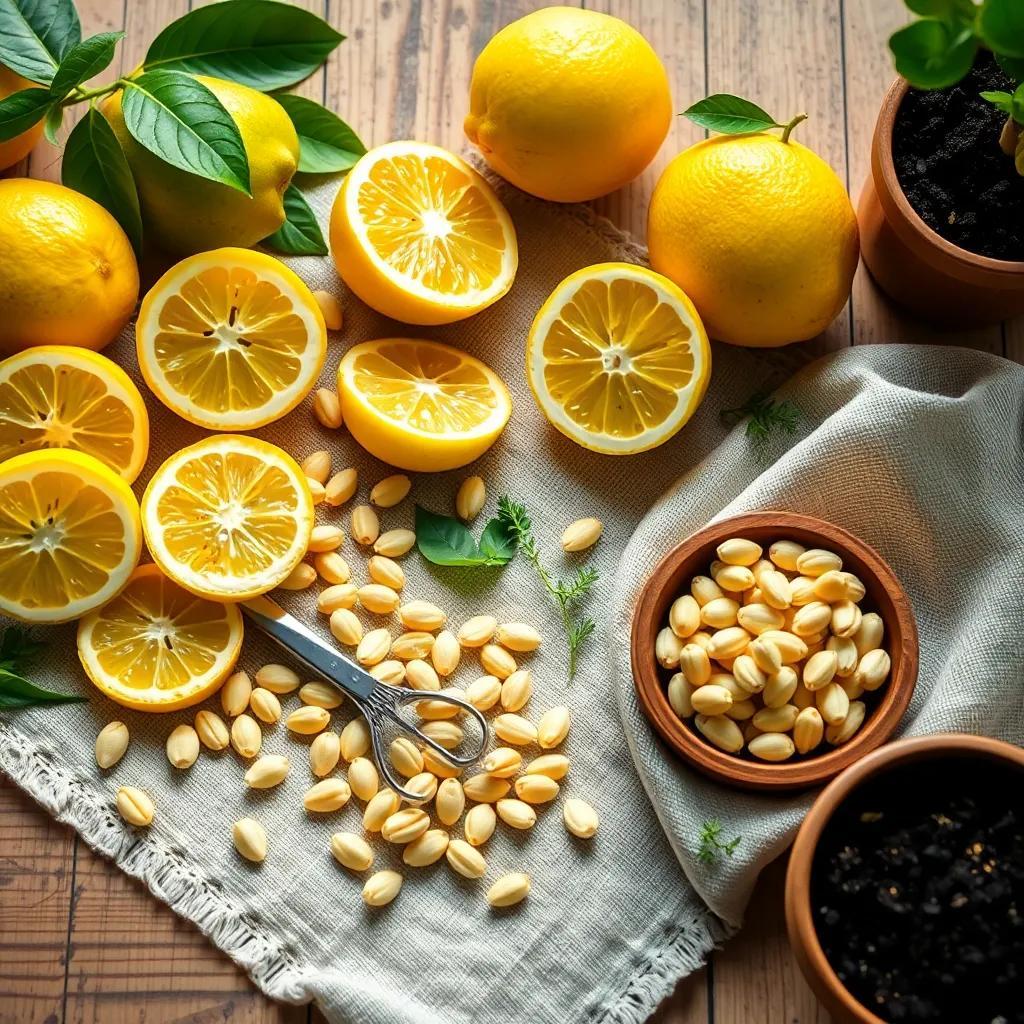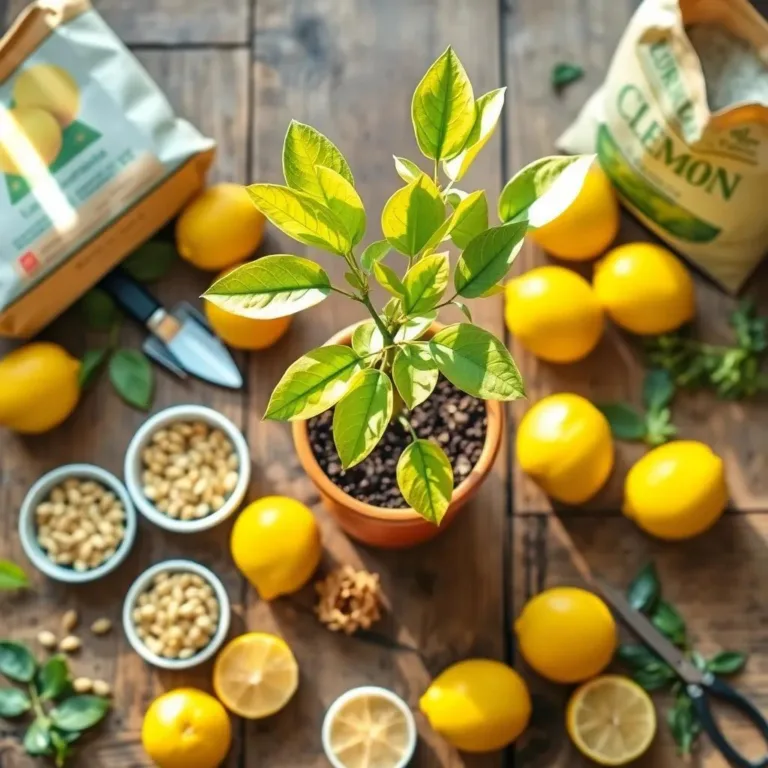Have you ever dreamed of growing your very own lemon tree? Imagine picking fresh lemons right from your backyard! In this guide, I’ll share everything you need to know about how to germinate lemon seeds, care for your seedlings, and eventually enjoy the sweet rewards of your hard work. Let’s get those citrus adventures started!
Factors Affecting Lemon Seed Germination Time
Growing your own lemon tree is such an exciting adventure! But before we see those little green sprouts, we need to understand what affects germination time. There are a few important factors that can make your seeds sprout faster or slower. Let’s break it down!
1. Seed Quality:
The quality of the lemon seeds is just like picking fresh fruit at the market! Fresh seeds are more likely to germinate quickly, while old or damaged seeds can hang around longer, waiting for a miracle. So, always use seeds from reputable sources. Keep an eye out for seeds that look plump and healthy!
2. Seed Treatment:
Did you know that there are fun ways to help speed up germination? Soaking your lemon seeds in water for several hours is a popular method! It softens the seed coat and encourages it to open up. Think of it as giving the seeds a little spa day before they get to work!
3. Soil Quality:
The soil plays a big role too! Lemon seeds prefer well-draining soil that’s rich in organic matter. A pH level between 5.5 and 6.5 is what they need to thrive! That’s like the perfect recipe for success. If the soil is too heavy, it could trap water and drown the seeds. Yikes!
4. Watering and Moisture:
Keeping the soil consistently moist is key to germination! However, overwatering can lead to root rot. You don’t want to set your seeds up for a swim in muddy soil! Checking moisture levels is a great habit to develop.
By knowing these factors, you’re one step closer to seeing those lemon seeds sprout! Isn’t that exciting? Now, let’s get those seeds ready for planting!
Techniques for Preparing Lemon Seeds for Planting
Alright, my fellow gardeners, it’s time to prep those seeds for their big debut! Properly preparing your lemon seeds can make all the difference. Here’s how I do it:
1. Seed Extraction:
First things first, I grab a ripe lemon! After slicing it open, I carefully remove the seeds. Don’t forget to rinse them gently to wash away any pulp. It’s like cleaning up after a party, right?
2. Seed Drying:
After rinsing, I let those seeds dry out completely. I place them on a clean paper towel or mesh screen, away from direct sunlight. Patience is key here! I generally wait about a week, or until they’re dry to the touch.
3. Seed Scarification:
Ready for a little fun? I lightly nick the outer layer of the seed coat with a small knife. This process, called scarification, helps water get inside the seed and speeds things up. Just be gentle; we don’t want to hurt our little seeds!
4. Seed Stratification:
Now, for some lemon magic! Some varieties like a cool winter experience (how wild is that?). I grab a plastic bag, put the seeds with a damp paper towel, and pop it into the fridge for about four weeks. This trick is super helpful to wake those seeds up in spring!
By following these preparation techniques, you’re getting your lemon seeds ready for their new home in the soil. It’s all about giving them the best start possible! Are you excited to see those sprouts? I know I am! Let’s keep the momentum going as we dive into the best practices for planting lemon seeds!

Best Practices for Planting Lemon Seeds
Alright garden friends, now that our lemon seeds are prepped and ready to go, it’s time to talk about the best practices for planting them! Getting this part right will help those little seeds sprout into strong lemon trees. Here’s how I do it!
1. Choosing the Right Container:
I love using pots with drainage holes! These help prevent the soil from getting too soggy, which can drown the seeds. A container that’s about 8-10 inches deep is perfect. It gives the roots enough space to grow!
2. Soil Selection:
Next up is the soil! I always use a well-draining seedling mix or a mix of potting soil and vermiculite. Heavy garden soil can be a bummer because it doesn’t drain well. Before planting the seeds, I moisten the soil slightly to create a cozy environment for the seeds.
3. Seed Placement:
Now it’s planting time! I plant the lemon seeds about 1 inch deep in the soil. If I’m using a larger container, I like to space out the seeds evenly. Once they start growing, I can thin them out and keep just the strongest one!
4. Light and Temperature:
After planting, I place the container in a warm spot where it can get 6-8 hours of indirect sunlight daily. If my home doesn’t get enough natural light, I use grow lights. I keep the temperature consistent between 70-85°F (21-29°C), which is just perfect for germination.
Using these planting practices makes the process exciting and rewarding! Soon enough, I’ll be seeing sprouts peeking through the soil, and nothing feels quite like that!
Understanding the Lemon Tree Germination Process
So, now we’ve planted our seeds, and the waiting game begins! What happens next? Let’s dive into the germination process and what we can expect as our lemon seeds get cozy in their new home!
1. Seedling Emergence:
After planting, it usually takes about 2 to 4 weeks for lemon seeds to germinate. During this time, the seeds will soak up water, swell, and eventually crack open. It’s like a little surprise gift waiting to be unwrapped! Once the seed cracks, a tiny root will start to grow down into the soil, looking for nutrients.
2. Leaf Development:
Shortly after the root appears, a shoot will start to push through the soil. This shoot will develop into the plant’s first leaves, called cotyledons. They’re like the baby leaves that give the plant energy until it grows its true leaves, which will look like the classic lemon tree leaves we recognize!
3. Seedling Care:
As exciting as it is to watch the seeds sprout, proper care is critical during this time! I make sure they get enough light, whether it’s from the sun or my trusty grow lights. Keeping the temperature right and the soil consistently moist but not soggy is essential too!
4. Transplanting:
Once the seedlings have true leaves and are a few inches tall, it’s time for their next adventure! I carefully transplant each seedling into its own pot. This gives them space to grow bigger and stronger.
The germination process is filled with anticipation, and it’s all about nurturing these little wonders as they develop into healthy lemon trees!
Essential Care Tips for Growing Lemon Seedlings
Now that we have our lemon seedlings happily sprouting, it’s time to talk about the essential care tips for keeping them healthy and thriving! Taking good care of them ensures they grow strong and eventually produce delicious lemons.
1. Light and Temperature:
Lemon trees love sunshine! I make sure my seedlings get at least 6-8 hours of direct sunlight each day. If I can’t provide enough natural light, I use grow lights to supplement. Keeping a consistent temperature between 55-85°F (13-29°C) is also important. My seedlings need to feel cozy, just like I do on a chilly day!
2. Watering:
Regular watering is key to their success! I water my seedlings deeply but carefully to prevent soggy soil. I make sure the top inch of soil dries out between waterings. Watching my seedlings flourish with just the right amount of moisture is rewarding!
3. Fertilizing:
To give my lemon trees a nutrient boost, I use a balanced citrus fertilizer. I follow the package instructions, usually fertilizing in early spring and again in late summer. It’s like giving them a tasty snack to grow strong!
4. Pruning:
As my lemon trees grow, I keep an eye on their shape. I prune any dead or crossing branches to allow light and air to reach all parts of the tree. Pruning encourages a strong structure, which is super helpful!
5. Pest and Disease Control:
Pests can be a sneaky enemy! I regularly check my seedlings for any signs of pests like aphids or mealybugs. If I spot any trouble, I act quickly with organic options.
By putting these care tips into action, I’m setting my lemon trees up for a life full of growth and happiness! It’s such a joyful journey, and I can’t wait to see my trees flourish!

